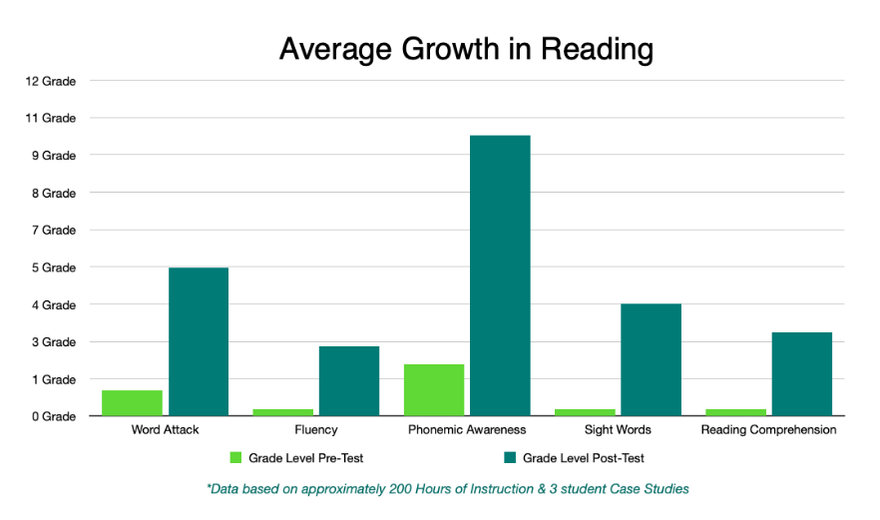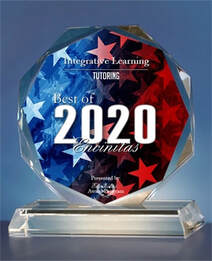Dyslexia TutoringOur dyslexia tutoring center offers a unique approach. We've written our own dyslexia reading program. This matters, because most dyslexia help centers take a highly eclectic approach, pulling from multiple programs in a haphazard way that can be confusing for students.
We've synthesized and integrated those programs to help readers build skills. Students don't just learn to read. They become people who can read to learn. "There are no universally effective programs, but there are knowable principles that need to be incorporated into all programs about how we teach written language." -Maryanne Wolf, researcher and parent, in Proust and the Squid, 2007, p. 209. Our program has been built on knowable principles and has proven its effectiveness over time. |
What is Dyslexia?
Dyslexia is a learning disability that impacts a person's ability to read. People with dyslexia have trouble reading at a good pace without making mistakes. They may also have a hard time with reading comprehension, spelling, and writing. In fact, dyslexia in children can result in a wide array of academic problems.
They do not have these problems because they lack intelligence. Dyslexic people aren't impaired. They're special. Unique. Visionary. Their brains simply absorb information in a different way. What most people think of when they hear "dyslexia" is a reading disability. They think of backwards words and transposed letters. As tutors, we understand the nature of dyslexia. According to Ronald D. Davis' The Gift of Dyslexia, this condition is not a disorder, but rather a unique formation of the brain that causes a person to see the world in three dimensions rather than two. For instance, imagine a book, or any other 3-D object within your view. If you turn that object upside down, is it still a book? If you turn it on its side, is it still a book? Yes, because that object exists in three dimensions. However, numbers and letters on paper are two-dimensional, so if you rotate them, they change their identity. A "p" becomes a "q," a "b" becomes a "d", an "m" becomes a "w." To a dyslexic mind, this is highly confusing and frustrating. The gift of dyslexia is being able to see the whole picture at once. It's being able to make huge intuitive and creative leaps in thinking that lead a person to the problem's answer without having to take all the usual steps to get there. It's having the unique perspective to see all possibilities from all angles. It's being completely confounded by the small, mundane, rote, basic forms of learning, yet being able to master the advanced, abstract concepts meant for older, more experienced students, without even trying. Dyslexia Evaluations
You can get a dyslexia evaluation from a number of different professionals, including a child psychologist if you have one. If you don't, you don't have to worry.
Your options are:
|
Signs of Dyslexia in Children
The signs of dyslexia in kids will be different depending on their grade level. Here are the most common, by age and grade.
Note that these children will also show strengths, not just symptoms. For example, you may observe your child has curiosity and an amazing imagination. These children often have an incredible ability to figure things out, or to get the gist of them. They're eager to embrace new ideas, and have a good understanding of new concepts. Children with dyslexia often display a surprising level of maturity and have a larger vocabulary than is typical for their age group. They also often enjoy solving puzzles, have a talent for building models, and have an excellent comprehension of the stories read or told to them. Older children will have excellent thinking skills, including conceptualization, reasoning, imagination, and abstraction. They simply learn better through meaning, rather than via rote memorization. They have the ability to get the "big picture" and have a high level of understanding when taught through the spoken word. Looking for strengths as well as weaknesses is an important part of evaluating your child's needs. The Preschool Years
Kindergarten & First Grade
Second Grade Through High School
In older children, these symptoms may not be absolute. They can read and understand overlearned or highly practiced words. For example, a child who loves cooking will be able to read food magazines and cookbooks. These children will also often excel in areas that don't depend on reading, such as math, computers, visual arts, philosophy, biology, social studies, neuroscience, and creative writing. Young Adults and Adults
Adults and young adults typically have exceptional empathy and display a lot of warmth. They tend to have a talent for high-level conceptualization and have the ability to come up with original insights. Their inclination is to think outside the box and to see the big picture, and they often emerge noticeably resilient, and are able to adapt to a wide variety of situations. If your children are experiencing any of the above-referenced symptoms of dyslexia, contact us today to schedule an assessment. As you can see, we help adults as well, so don't hesitate to reach out to us if you need us. |
Types of Dyslexia Every brain is different, and so is every person with dyslexia. Here are some of the most common forms.
Verbal DyslexiaVerbal dyslexia is also known as "aphasia." Aphasia makes it difficult to understand what the child is saying. It's difficult for these children to produce speech and retrieve sounds. They need the services of speech and language specialists.
Eventually, when someone with aphasia begins to read and write, they may also have difficulty, because they will struggle with applying sounds to images. Auditory DyslexiaAuditory dyslexia makes it difficult to process sound or manipulate language. For example, the student with auditory dyslexia can struggle to recognize the subtle differences in sounds, like hearing the difference between a short "i" and a short "e."
The majority of people with dyslexia show problems with short-term verbal memory, and experience significant difficulties in auditory processing. They will face challenges with following instructions, recalling things like the alphabet or months of the year, and with concentration. They're often distracted by background noise and will struggle to take notes when information is presented orally and at a rapid pace. They may also struggle to think of the right word or name, with attaching names to places or to people. Before assuming auditory dyslexia it's important for children to get a hearing test to make sure there's no physical impediment. Spelling Dyslexia
Spelling is one of the biggest, most widely experienced difficulties for the dyslexic child and adult. That means that dyslexic individuals can have difficulty hearing the different small sounds in words (phonemes) and can't break words into smaller parts in order to spell them.
Dyslexia can impact spelling when students can't hear the small units of sound that represent meaning. They therefore have difficulty in encoding and decoding sounds, skills that are necessary in order to manipulate them. People with dyslexia often confuse letters and sounds alike. Vowels can be especially tricky. They may mix up the order of letters (felt for left.) They may also misspell common sight words, even after lots of practice. Writing DyslexiaWriting dyslexia involves difficulty with the physical act of writing. Kids may find it hard to organize and express their thoughts in written form.
There is often a large discrepancy between what a student thinks and can tell you orally and what he can write down on paper. Spelling errors are frequent. They may write essays as one paragraph with several long, run-on sentences. They may use very little punctuation, including not capitalizing the first word in a sentence or using end punctuation. They may space words oddly, or fail to space them at all. They may also cram information on the page rather than spreading it out. They may jump around, and put events out of sequence. They may also show signs of dysgraphia, including illegible handwriting, and taking a long time to form letters and write assignments. They may find the process time-consuming and frustrating. |
Dyslexia Treatment
Kids with dyslexia don't outgrow it. But there are teaching approaches and strategies that can help people with dyslexia improve their reading skills and manage the challenges.
We all have a natural fight-or-flight result that kicks in when fear strikes. Our heart speeds up. Our breathing speeds up. Sometimes, we just want to run. What happens when that fear is reading? For people with dyslexia, that fear factor can kick in when someone simply hands them a piece of paper. Our program offers dyslexia help that ensures kids can overcome this fear and become lifelong readers. Possible Causes of DyslexiaResearchers have yet to pinpoint the exact cause of dyslexia. They do know that genetics and differences in brain structure play a role.
If you have dyslexia, it's likely your child has it too. Brain imaging studies have shown the differences between people with or without dyslexia. These differences happen in areas of the brain involved with key reading skills. Those skills are knowing how sounds are represented in words and recognizing what written words look like. Brains can change. Studies show that brain activity in people with dyslexia changes after they get proper instruction or tutoring. IL's Approach to Dyslexia Therapy
Our team has been in the dyslexic and hyperlexic arena for over 30 years. We've mastered the art of teaching students who think and process information differently.
We created our unique program because there was no other program capable of encompassing all the methodologies necessary to truly master literacy. As the old saying goes: if you can't find it, make it yourself. That's exactly what we did. Students at IL receive the best of:
All wrapped up in our curriculum teaching:
Every age demands a different approach. Ideally, you'll bring your students to us as young as possible. While we can serve a child tackling their senior year in high school, starting early offers a highly effective preventative approach. |
Ready to Get Started?
We've got all the information you need right here.
How This WorksStudents will work through our multisensory dyslexia reading program at their own pace. This is a complete literacy program that incorporates spelling, writing, and reading comprehension skills.
Where This Works
Before COVID, we worked one-on-one and in small groups of two. Currently, we're only working virtually. Students still either work one-on-one with a tutor or in a small group of two.
How to Get Started
We schedule sessions according to age and test results. Sessions may be 50 minutes, 90 minutes, or 120 minutes long. The length of the sessions is also dictated by age and test results.
During the pandemic, we recommend Monday-Friday 50-minute virtual sessions. We've cut our rates by 20% to accommodate parents during the Covid-19 pandemic. Don't let your child fall behind. Call (760) 487-5245 today, or fill out our contact form today. |
Let us help your child discover the best version of themselves
For a free consult about how we can help
Tutoring |
JOIN OUR MAILING LIST
|
Contact Us |
Integrative Learning is not Lindamood-Bell Learning Processes. Integrative Learning is not affiliated with, certified, endorsed, licensed, monitored or sponsored by Lindamood-Bell, Nanci Bell, Phyllis Lindamood or Patricia Lindamood. Lindamood-Bell – an international organization creating and implementing unique instructional methods and programs for quality intervention to advance language and literacy skills – in no way endorses or monitors the services provided by Integrative Learning
Copyright © 2024 Integrative Learning
Website by McCullough Web Services
Website by McCullough Web Services


